Introduction
In the fast-paced world of software development, maintaining high-quality code is paramount for achieving maximum efficiency and productivity. Cyclomatic complexity, a metric introduced by Thomas J. McCabe in 1976, serves as a critical tool for developers to measure and manage the intricacy of their code. By quantifying the number of linearly independent paths through a program, cyclomatic complexity provides invaluable insights into code maintainability, testability, and readability.
This article delves into the definition, calculation, practical applications, and strategies for managing cyclomatic complexity, emphasizing its significance in enhancing overall code quality and development efficiency.
Definition and Purpose of Cyclomatic Complexity
Cyclomatic intricacy, introduced by Thomas J. McCabe in 1976, is a vital software metric that quantifies the difficulty of a program by counting the number of linearly independent pathways through its source text. This metric provides developers with a numerical value that reflects the intricacy of their work, impacting maintainability, testability, and readability. Elevated control flow intricacy frequently associates with increased technical liabilities, rendering the programming harder to oversee and more susceptible to mistakes. For example, a research on software quality showed that projects with reduced structural intricacy had notably fewer change failure rates, highlighting the significance of preserving straightforward, tidy programming. By analyzing control flow intricacy, teams can more effectively evaluate the risks linked to their programming, directing educated choices on restructuring and testing approaches to improve overall quality and development efficiency.
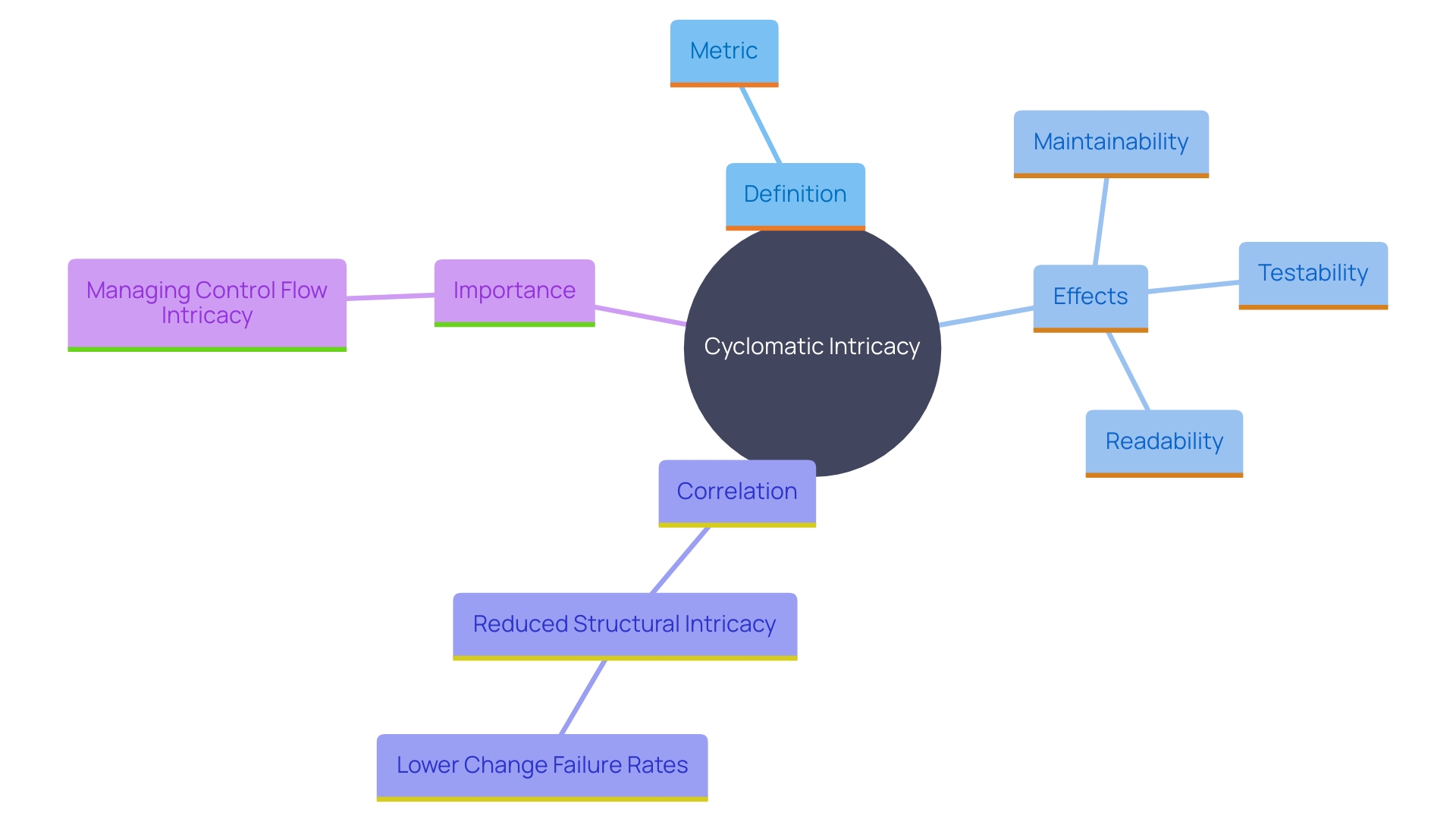
How Cyclomatic Complexity is Calculated
Determining the structural intricacy involves utilizing the control flow diagram of a program, where nodes signify sections of instructions, and edges illustrate control flow routes. The formula to calculate cyclomatic measure (CC) is CC = E - N + 2P, with E representing the number of edges, N the number of nodes, and P the number of connected components, usually 1 for a single program. This formula gives a numerical figure representing the intricacy of the program. Higher values suggest more intricate programming, which can pose greater challenges in testing and maintenance. As per recent research, a properly maintained codebase greatly decreases implementation duration and defect occurrences, highlighting the significance of managing code structure for improved software maintainability.
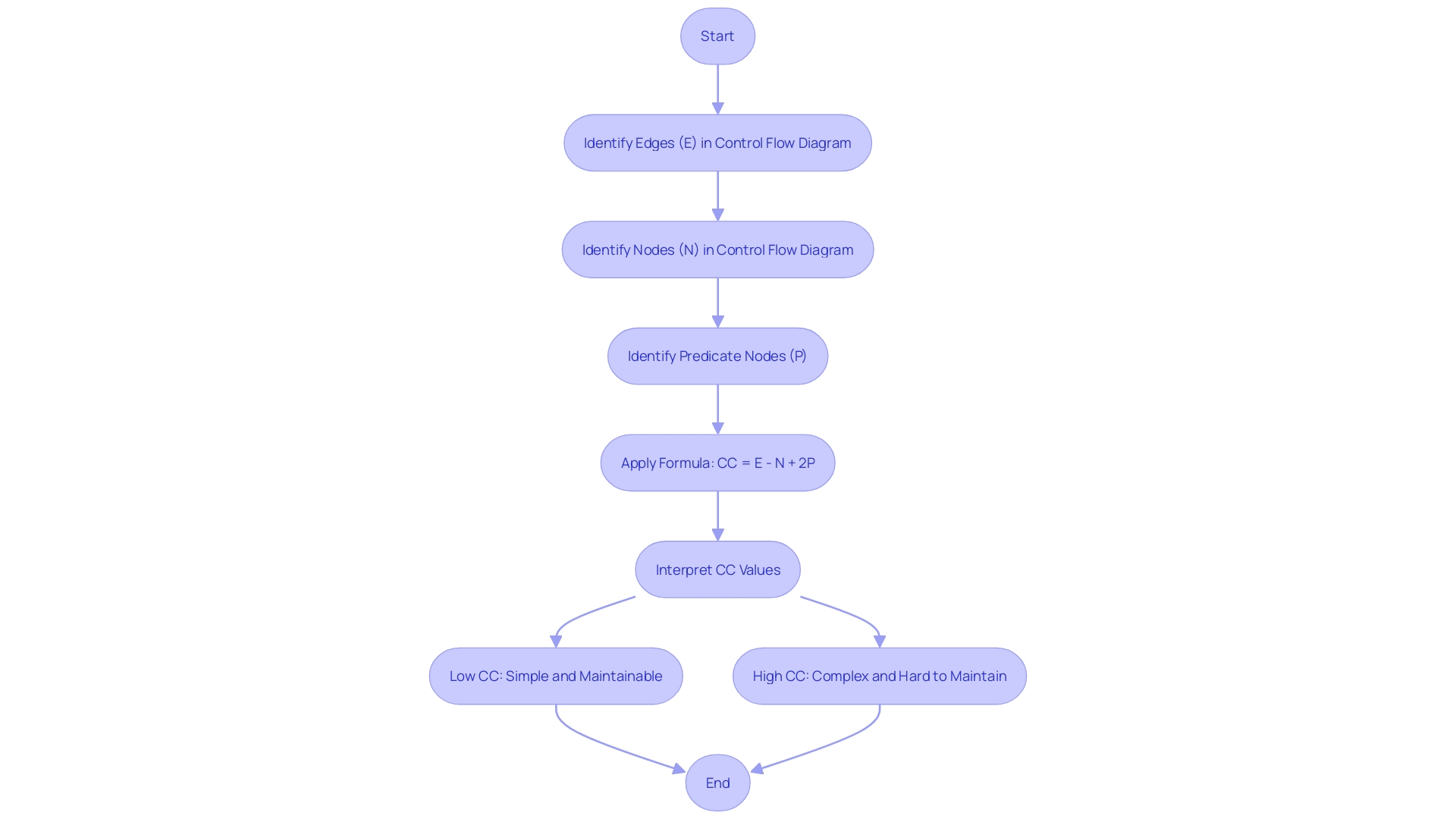
Understanding the Formula: E-N+2P
The equation for determining cyclomatic intricacy provides essential understanding of the structure and quality of the programming. 'Cyclomatic CC is determined using the equation CC = E - N + 2P, where E represents the number of edges (paths) in the program, N signifies the number of nodes (blocks of instructions), and P accounts for the number of connected components (entry points) in the application.'. This metric quantifies the number of linearly independent paths through the program, providing a clear picture of the decision points within a program.
By analyzing these components, developers can better understand the control flow within their applications, pinpointing areas that may be error-prone or in need of additional testing. For instance, a high level of interconnectedness often relates to a greater risk of errors, as intricate pathways can be more difficult to traverse and troubleshoot. This highlights the significance of keeping a balance between minimizing intricacy and ensuring readability and maintainability.
Furthermore, the idea of control flow measurement is essential for investigative software analysis, as emphasized by Adam Tornhill in 'Your Software as a Crime Scene.' Tornhill's approach utilizes historical data from source management to identify 'hotspots'—complex areas frequently modified, which can indicate architectural weaknesses and potential instability.
Developers can utilize these insights to establish approaches focused on diminishing structural intricacy without sacrificing other essential programming characteristics. For instance, creating smaller, more focused functions can simplify the code and make it easier to understand and maintain. By consistently assessing and controlling cyclomatic intricacy, development teams can improve the overall standard and stability of their software, making it simpler to navigate and less susceptible to faults.
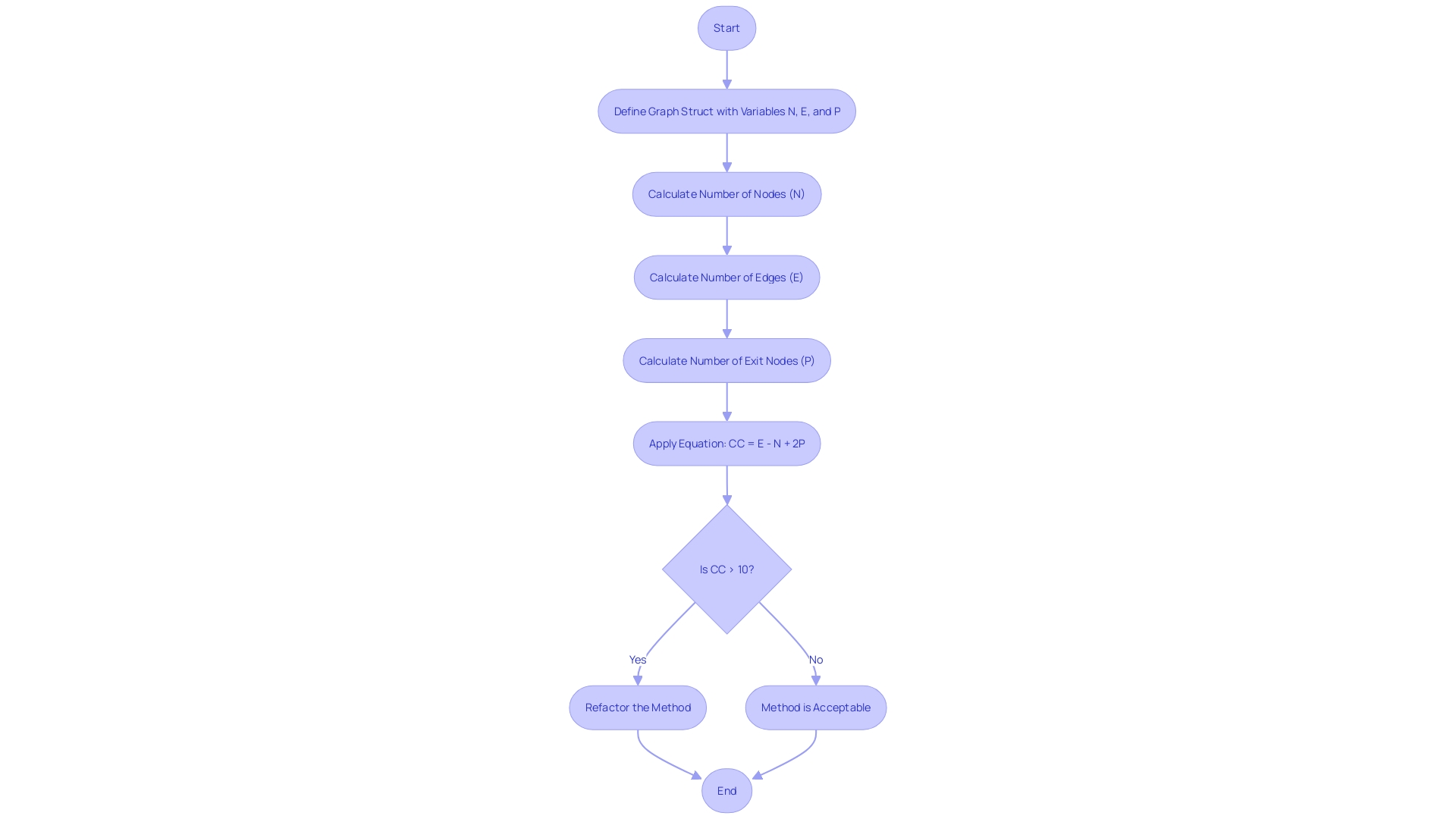
Practical Applications of Cyclomatic Complexity in Software Testing
Cyclomatic intricacy is an invaluable metric in software testing, aiding the design of robust test cases. 'With the fast-paced innovation in software, ensuring excellence and rapid release is crucial.'. Increased control flow intricacy indicates the need for additional test cases to encompass all possible code routes, tackling any potential edge situations. This metric allows QA teams to focus their testing efforts on the most intricate modules, thereby enhancing software quality and minimizing the risk of defects in production. Leveraging modern techniques, such as Large Language Models (LLMs) for test case generation, can further streamline the process. Studies have shown that LLMs can improve test case comprehensiveness, accuracy, and efficiency, although challenges like model interpretability and adaptation remain. However, by concentrating on intricate regions recognized through code analysis metrics, teams can allocate resources efficiently, leading to significant cost reductions and an improved return on investment in software testing.
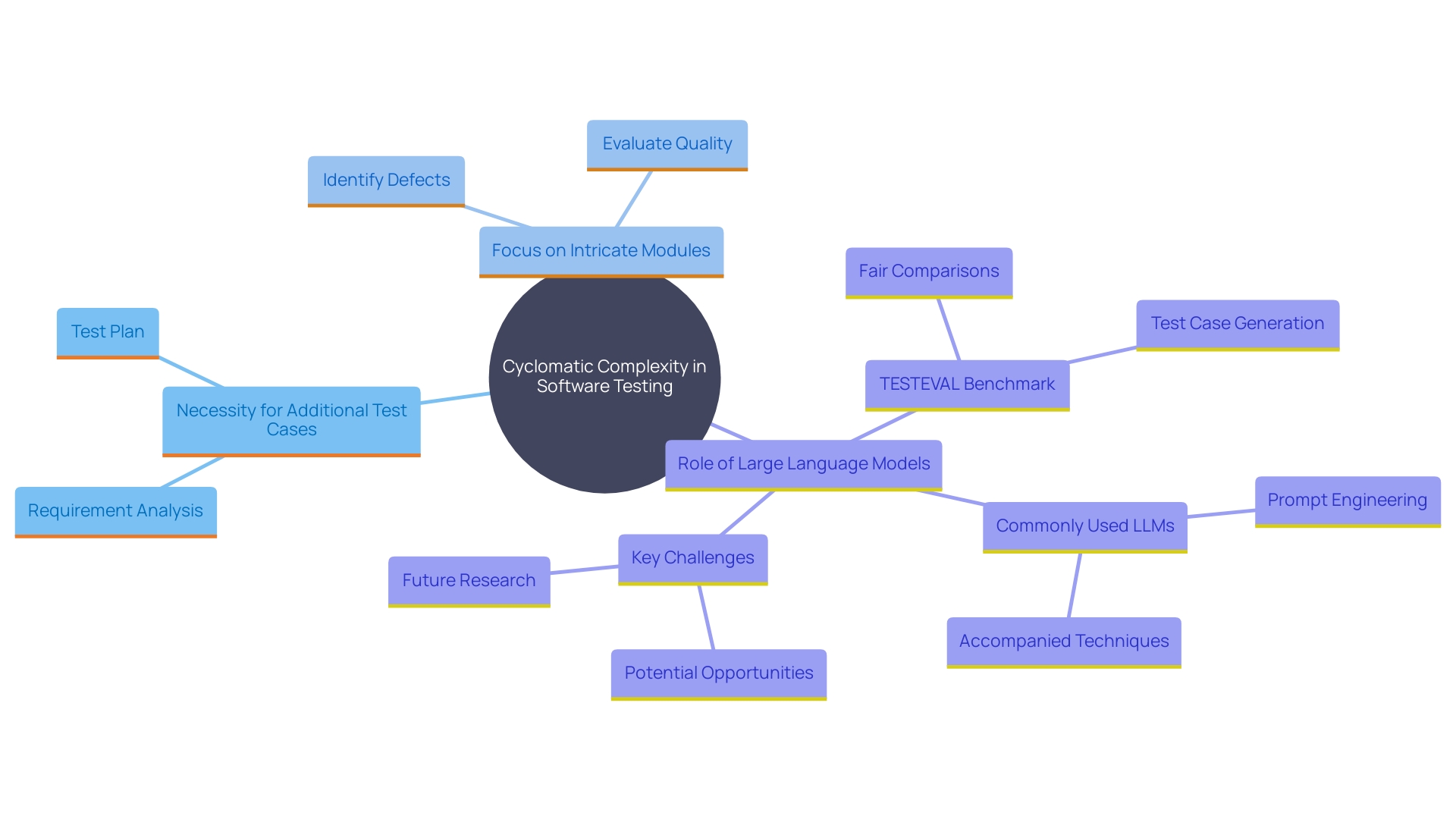
Relationship Between Cyclomatic Complexity and Code Maintainability
Cyclomatic intricacy plays a vital role in assessing software maintainability. Elevated control flow intricacy frequently associates with heightened challenges in comprehending, altering, and assessing software. This intricacy makes the program more susceptible to errors and technical debt. As observed, non-optimal decisions in software projects can lead to short-term gains but harm long-term maintenance. Managing technical debt effectively is essential to prevent these issues.
Efforts to reduce cyclomatic complexity can significantly improve the quality of the program. By minimizing decision points in the programming, developers can create more streamlined and manageable systems. This approach not only facilitates smoother updates and enhancements but also reduces the risk of errors. For instance, research has shown that working in unhealthy programs can extend task implementation times by up to an order of magnitude compared to healthier codebases. This disparity can put businesses at a competitive disadvantage.
The historical evolution of CASE tools demonstrates how automated tools have been instrumental in improving software development processes. From the 1980s onwards, advancements in these tools have enabled more efficient coding practices, integrating design and development phases to streamline conceptualization to implementation transitions. This evolution underscores the importance of leveraging modern tools and techniques to manage cyclomatic complexity and maintain a healthy codebase.
Additionally, the rise of AI coding techniques has introduced new challenges and opportunities. While AI can speed up development, it also emphasizes the necessity for careful management of software quality to avoid long-term maintenance problems. Excessive use of copied and pasted material, for example, is a well-known issue that can severely affect maintainability.
In summary, aiming for reduced control flow is essential for developing more maintainable and resilient software. By utilizing contemporary instruments and methods, developers can efficiently handle technical debt and guarantee long-term software standards.
Limitations and Considerations of Cyclomatic Complexity
Although the measure of control flow is an important indicator for evaluating software standards, it has some restrictions. This metric does not consider other critical aspects such as readability, design patterns, or the overall architecture of an application. A study highlights the importance of sustaining high programming standards, noting that developers frequently adjust their contributions according to existing standards. Furthermore, cyclomatic intricacy might not accurately reflect challenges introduced by external dependencies or asynchronous operations. Therefore, to achieve a comprehensive view of software quality, it should be used alongside other metrics and qualitative assessments. An examination showed that while sustainability measures do not notably influence defect density or coverage, elements such as risk intricacy and duplication percentage are impacted. Therefore, combining control flow intricacy with additional instruments can offer a more comprehensive view of software quality and sustainability.
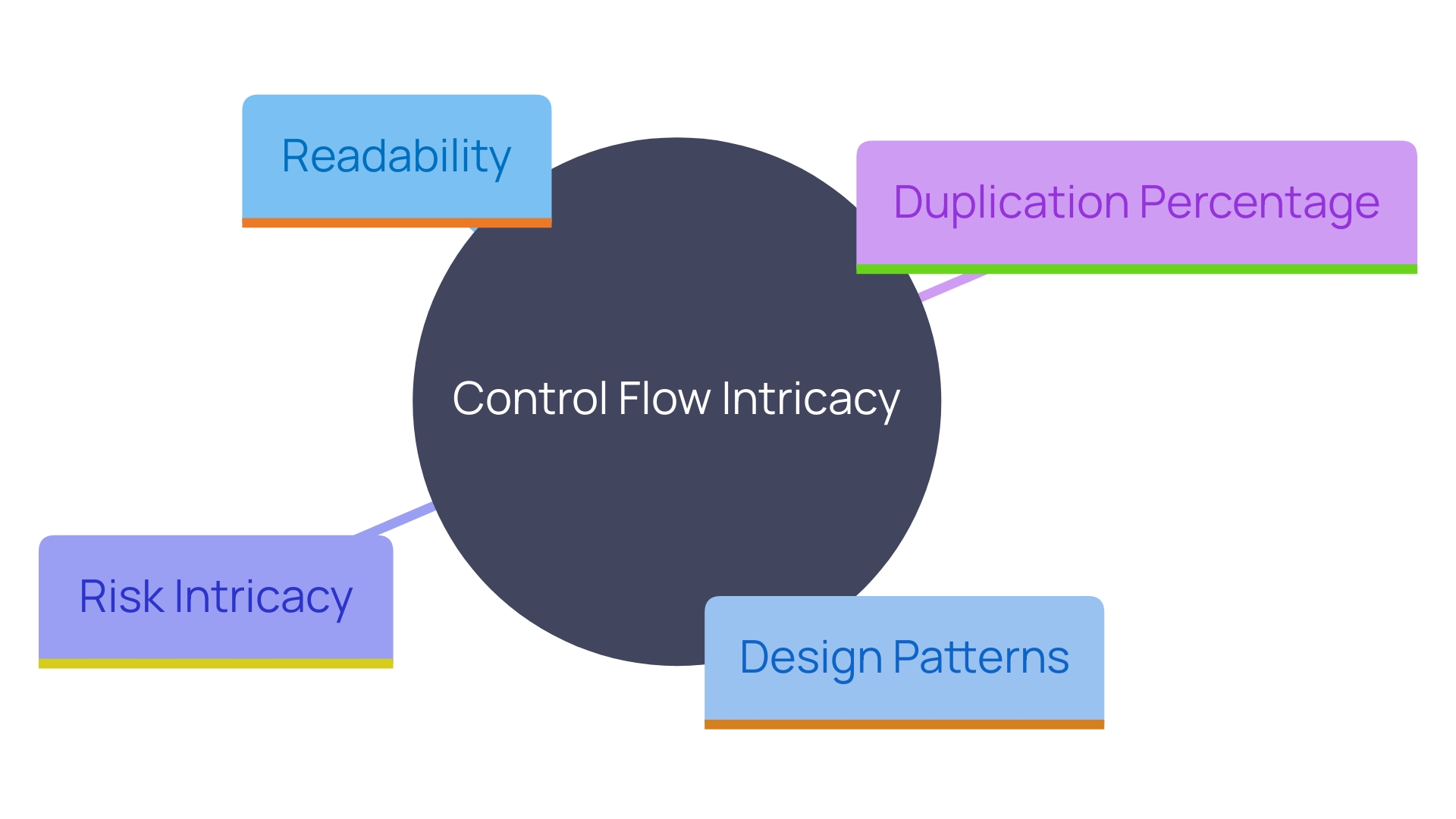
Strategies for Reducing Cyclomatic Complexity
To decrease cyclomatic intricacy, developers can employ several effective strategies. 'Refactoring the program to eliminate unnecessary conditional statements is crucial as it simplifies the structure, making it easier to understand and maintain.'. Dividing large functions into smaller, more manageable ones not only decreases difficulty but also improves readability and enables simpler testing and debugging. Utilizing design patterns can additionally aid in reducing complexity by offering tested solutions to frequent issues, thereby encouraging reuse and consistency.
Adopting a consistent programming style across the team ensures that the scripts remain uniform and easier to read, preventing misunderstandings and reducing the learning curve for new team members. Frequent evaluations of programming maintain simplicity and quality. As highlighted by Google's experience, the impact of machine learning-suggested code edits has been instrumental in boosting productivity by allowing engineers to focus on more creative and complex tasks, thereby reducing the time spent on code reviews by hundreds of thousands of engineer hours annually.
Visualization tools such as Dep Tree can also assist in handling intricacy by depicting the 'entropy' of a codebase and visualizing its structure through a 3D force-directed graph. This helps developers identify and address areas of high complexity effectively. Moreover, insights from large-scale data analysis, such as the study conducted on 1.5 million pull requests, indicate that minimizing file touchpoints in each PR correlates with faster merge times, underscoring the importance of well-architected systems.
Ultimately, these practices contribute to a healthier codebase, leading to better software and enhanced business value. A well-maintained codebase not only improves development efficiency but also mitigates risks associated with technical debt and long-term maintenance, as evidenced by empirical data demonstrating the significant business advantages of maintaining 'Green Code' quality.
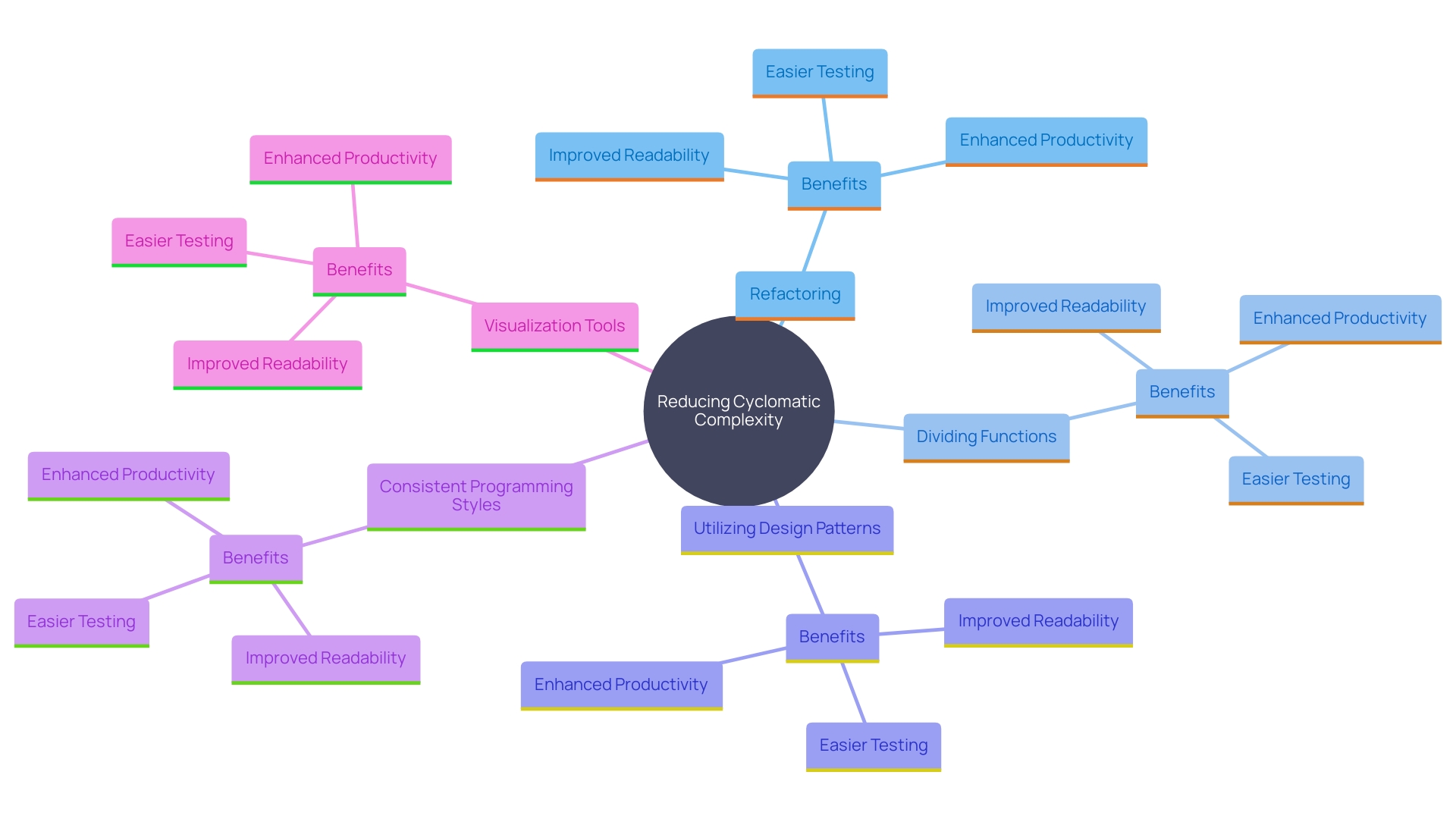
Conclusion
Cyclomatic complexity serves as an essential metric in software development, providing insights into code maintainability, testability, and overall quality. By quantifying the number of independent paths through the code, it enables developers to identify areas that may require refactoring or additional testing. High cyclomatic complexity is often linked to increased technical debt and a higher likelihood of defects, emphasizing the need for teams to prioritize simplicity and clarity in their coding practices.
Effective calculation and management of cyclomatic complexity can lead to substantial improvements in software efficiency. Strategies such as breaking down large functions, adopting consistent coding styles, and utilizing visualization tools contribute to a healthier codebase. By focusing on reducing complexity, development teams not only enhance code quality but also streamline their workflows, ultimately resulting in significant cost savings and improved productivity.
Incorporating cyclomatic complexity into the software development process fosters a culture of continuous improvement. By leveraging modern tools and methodologies, teams can navigate the challenges of software complexity, ensuring that they produce high-quality, maintainable code. This proactive approach not only benefits individual projects but also strengthens the long-term viability of software solutions in a competitive landscape.
Frequently Asked Questions
What is cyclomatic intricacy?
Cyclomatic intricacy, introduced by Thomas J. McCabe in 1976, is a software metric that quantifies the difficulty of a program by counting the number of linearly independent pathways through its source code. It serves as a numerical value reflecting the intricacy of the code, which impacts maintainability, testability, and readability.
How is cyclomatic intricacy calculated?
Cyclomatic intricacy is calculated using the formula CC = E - N + 2P, where: E = number of edges (paths) in the program, N = number of nodes (blocks of instructions), P = number of connected components (typically 1 for a single program).
Why is cyclomatic intricacy important in software development?
Elevated cyclomatic intricacy is often associated with increased technical liabilities, making the software harder to manage and more prone to errors. Research indicates that projects with lower structural intricacy have fewer change failure rates, highlighting the need for simpler and cleaner programming.
How can analyzing cyclomatic intricacy improve software quality?
By analyzing cyclomatic intricacy, teams can identify complex areas of the code that may be error-prone and require additional testing. This allows for informed decisions regarding code restructuring and testing strategies, ultimately enhancing software quality and development efficiency.
What challenges does high cyclomatic intricacy pose?
High cyclomatic intricacy can lead to greater difficulties in testing and maintaining software. It often results in longer implementation times and higher defect rates, as intricate pathways are more challenging to navigate and troubleshoot.
How does cyclomatic intricacy relate to software testing?
Cyclomatic intricacy aids in designing effective test cases by indicating where more tests are needed to cover all possible code paths. QA teams can focus their efforts on the most complex modules, improving software quality and minimizing production defects.
What strategies can developers use to reduce cyclomatic intricacy?
Developers can reduce cyclomatic intricacy by: Refactoring code to eliminate unnecessary conditional statements, Breaking down large functions into smaller, more manageable pieces, Utilizing design patterns for consistency, Adopting a uniform programming style across the team, Using visualization tools to identify complex areas in the codebase.
Are there limitations to using cyclomatic intricacy as a metric?
Yes, cyclomatic intricacy does not consider factors such as code readability, design patterns, or the overall architecture of the application. It should be used alongside other metrics and qualitative assessments for a comprehensive view of software quality.
What is the impact of technical debt on cyclomatic intricacy?
High cyclomatic intricacy can contribute to technical debt, making software harder to understand and maintain. Managing technical debt is crucial to prevent long-term issues and ensure sustainable software development.
How can modern tools and techniques help manage cyclomatic intricacy?
Modern tools, including AI coding techniques and automated CASE tools, can improve development processes by streamlining coding practices and enhancing the maintainability of the codebase. These tools assist in managing cyclomatic intricacy and fostering a healthier code environment.




